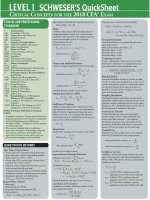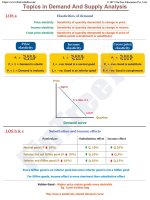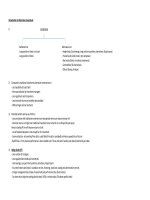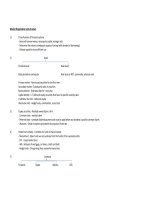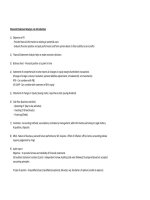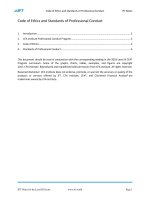CFA 2018 level 1 schweser s quicksheet
Bạn đang xem bản rút gọn của tài liệu. Xem và tải ngay bản đầy đủ của tài liệu tại đây (3.3 MB, 6 trang )
C r i t i c a l C o n c e pt
d
^
ETHICAL AND PROFESSIONAL
STANDARDS
___________________________________________________________________________________________________________
I
1(A)
1(B)
1(C)
1(D)
II
11(A)
11(B)
III
III (A)
III(B)
III(C)
III(D)
III(E)
IV
IV(A)
IV(B)
IV(C)
V
V(A)
V(B)
V(C)
VI
VI (A)
VI(B)
VI (C)
VII
VII(A)
VII(B)
Professionalism
Knowledge of the Law.
Independence and Objectivity.
Misrepresentation.
Misconduct.
Integrity of Capital Markets
Material Nonpublic Information.
Market Manipulation.
Duties to Clients
Loyalty, Prudence, and Care.
Fair Dealing.
Suitability.
Performance Presentation.
Preservation of Confidentiality.
Duties to Employers
Loyalty.
Additional Compensation Arrangements.
Responsibilities of Supervisors.
Investment Analysis, Recommendations,
and Actions
Diligence and Reasonable Basis.
Communication with Clients and
Prospective Clients.
Record Retention.
Conflicts of Interest
Disclosure of Conflicts.
Priority of Trans actio ns.
Referral Fees.
Responsibilities as a CFA Institute
Member or CFA Candidate
Conduct as Participants in CFA Institute
Programs.
Reference to CFA Institute, the CFA
Designation, and the CFA Program.
Global Investment Performance Standards
(GIPS®)
• Compliance statement: “ [Insert name of firm] has
prepared and presented this report in compliance
with the Global Investment Performance
Standards (GIPS).” Compliance must be applied
on a firm-wide basis.
• Nine sections: fundamentals of compliance,
input data, calculation methodology, composite
construction, disclosures, presentation and
reporting, real estate, private equity, and wrap
fee/separately managed account portfolios.
2018 CFA® E x a m
s for t he
Approximation formula for nominal required rate:
E(R) = RFR + IP + RP
Means
Arithmetic mean: sum of all observation values in
sample/population, divided by # of observations.
Geometric mean: used when calculating investment
returns over multiple periods or to measure
compound growth rates.
Geometric mean return:
Rc= (1 + R,)x...x(l + RN) P - 1
harmonic mean = N
N
E
i=i .5 c ,
Jl^
V
1
Variance and Standard Deviation
Variance: average of squared deviations from mean.
!>.—u
N
P)'
2
population variance = cr = — -----N
n
sample variance - s2- i=i
x)2
n —1
Standard deviation: square root of variance.
H olding Period Return (HPR)
P , - P ^ + D,
+
P.-i
P«-i
Coefficient o f Variation
Coefficient o f variation (CV): expresses how much
dispersion exists relative to mean of a distribution;
allows for direct comparison of dispersion across
different data sets. CV is calculated by dividing
standard deviation of a distribution by the mean or
expected value of the distribution:
cv = 4
X
Sharpe Ratio
Sharpe ratio: measures excess return per unit of risk.
Sharpe ratio =
rP ~ rf
Expected return, variance o f 2-stock portfolio:
E ( R P) =
w a
E(R a ) +
w b E(Rb)
Var( R p) = WAa 2 (R a ) + W2B<72 ( R b )
+ 2 w a w b
Normal Distributions
Normal distribution is completely described by its
mean and variance.
68% of observations fall within ± la .
90% fall within ± 1.65a.
95% fall within ± 1.96a.
99% fall within ± 2.58a.
Computing Z-Scores
Z-score: “standardizes” observation from normal
distribution; represents # of standard deviations a
given observation is from population mean.
z=
observation —population mean
x —/x
standard deviation
<7
Binomial Models
Binomial distribution: assumes a variable can take
one of two values (success/failure) or, in the case of
a stock, movements (up/down). A binomial model
can describe changes in the value of an asset or
portfolio; it can be used to compute its expected
value over several periods.
Sampling Distribution
Sampling distribution: probability distribution of
all possible sample statistics computed from a set of
equal-size samples randomly drawn from the same
population. The sampling distribution o f the mean is
the distribution of estimates of the mean.
Central Limit Theorem
Central lim it theorem: when selecting simple
random samples of size n from population with
mean p, and finite variance a 2, the sampling
distribution of sample mean approaches normal
probability distribution with mean |i and variance
equal to o2ln as the sample size becomes large.
Standard Error
Standard error o f the sample mean is the standard
deviation of distribution of the sample means.
known population variance: cr- =
QUANTITATIVEMETHODS
Time Value o f M oney Basics
• Future value (FV): amount to which investment
grows after one or more compounding periods.
• Future value: FV = PV(1 + I/Y)N.
• Present value (PV): current value of some future
cash flow PV = FV/(1 + I/Y)N.
• Annuities: series of equal cash flows that occur at
evenly spaced intervals over time.
• Ordinary annuity: cash flow at ^W-of-time period.
• Annuity due: cash flow at beginning-of-time period.
• Perpetuities: annuities with infinite lives.
PVperpetuity
. = PMT/(discount
rate).
v
'
Required Rate o f Return
Components:
1. Real risk-free rate (RFR).
2. Expected inflation rate premium (IP).
3. Risk premium.
E(R) = (l + RFRreal)(l + IP)(l + RP) —1
Roy’s safety-first ratio:
rp
fiarget
CT„
For both ratios, larger is better.
Expected Return/Standard Deviation
Expected return: E(X ) = ^ ^ P ( x j) xn
E(X ) = P (x1)x 1+ P ( x 2)x2 + . . . + P (xn)x n
Probabilistic variance'.
a 2( X ) = y > ( x i ) [ x i - E ( X ) f
= P(x1)[x1-E (X )f + P(x2)[x2-E(X )]:
+ ... + P(xn)[x„—E(X)f
corrlR ^R : =
COV (Rj, Rj
a
r*
unknown population variance: s? =
Confidence Intervals
Confidence interval: gives range of values the mean
value will be between, with a given probability (say
90% or 95%). With known variance, formula for a
confidence interval is:
x ± za l l
Za/2
Z\x!2
,=
Standard deviation: take square root of variance.
Correlation and Covariance
Correlation: covariance divided by product of the
two standard deviations.
a -r b )
Z
a/2
=
a
1.645 for 90% confidence intervals
(significance level 10%, 5% in each tail)
1.960 for 95% confidence intervals
(significance level 5%, 2.5% in each tail)
2.575 for 99% confidence intervals
(significance level 1%, 0.5% in each tail)
